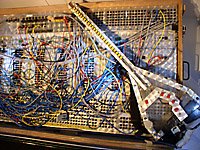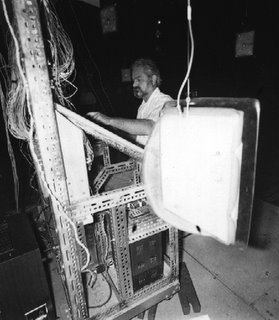Another interesting piece. Details below by Stephen of
parsick.com. Title link takes you to Codex flores, what appears to be the home of the BRONTOLOGIC. Thanks Stephen!
Unfortunately I couldn't find a bigger shot.
Update: bigger pic below.

"The Brontologic was designed by a certain Werner Lambertz who had originally made a fortune selling jeans trousers (of all things...) in Germany in the 1970s. The first instrument was presented around 1979/1980. Lambertz´ idea was to design a musical computer that automatically produced good music, without any faults that musicians would create. Later, Kurt "Pyrolator" Dahlke of Germany´s proto electro band Der Plan (The Plan) wanted another machine like that as he felt this was something he could push the limits with, thus he started building a second Brontologic, assisted by Lambertz, in around 1980/81.
Basically, it was a sequencer which had several counters running in parallel, synced to a master clock. It was capable of producing up to six (I think) sequences at the same time, all running at different rates, having different numbers of steps, and all could be set up to different cycling modes independent from each other. I never quite figured how pitches were determined as it had no pots for adjusting voltages, just half a million of banana patch sockets. I guess each patch point in a horizontal row represented one pitch while the sequencer progressed vertically from the top to the bottom (though I have no evidence for that). It allowed the user to interact with the sequencer patterns, have one play backwards, have another stop at a certain point, or have yet another one shift its start and end points continously during playback. When fully patched up, it looked like "Spaghetti Bolognese" as Dahlke once pointed out. As an external controller the operator used some thing called "DIGitarre", made of stainless steel tubing and shaped vaguely guitar-like with loads of switches which allowed control over certain parameters of the Brontologic. Dahlke later admitted it was sort of bizarre to use this controller which clearly resembled the traditional rock´n´roll-type guitar while they were trying to get away from these overused r´n´r clichés.
In a 1993 interview with Germany´s KEYBOARDS magazine, Dahlke briefly explains the Brontologic. He used it to control his Korg MS-20 and later, he had an Emulator One interface built into it. Functionally, Dahlke compared the Brontologic with Buchla´s Thunder which allowed for similarly complex interactions with parameters and sequences on a MIDI level. I´m sorry I don´t have this issue available right now, maybe some fellow AHer could look it up for me (May 1993 issue, I think).
In my view, this device was sort of a comedy of errors. It must have been immensely expensive, and it was huge (about 2.5 metres square). It had an intimidating user interface, and it took ages to patch up. I think something along these lines could have been made in a simpler manner (like having a Serge Touch Keyboard Sequencer) but at that time Serges weren´t hugely popular in Germany. Neither were Buchlas. It seems to me that the Brontologic was best-suited for fractal-like sequencer patterns.
There is a nice track (180°) by Der Pyrolator on a compilation called "Verschwende Deine Jugend" (waste your youth) which sounds very much like a blueprint for the Node track "Alternator", all done on Korg MS-20 and Emulator One, most probably controlled by the Brontologic.
Sorry not to have more info,
Stephen."
 Update
Update via marcel: "on
http://gesellschaftsinseln.de/punkbuch/fotos_78.html you'll find one bigger pic of the bronto, and much more old punk pixs
site is made from the author of "verschwende deine jugend", a book about punk and new wave in germany, juergen teibel"
Update via pyrolator in the comments:
"I found this article, not all of it is correct, but nevertheless thank you for talking about it. The Brontologik2 is now standing in a museum and I decided to write it in Max/Msp with a few further modifications, which was called the bronotlogik3. About two years ago I saw the monome and the potential to be the perfect controller for the brontologik4, which is written for the monome256.
More informations:
http://brontologik.blogspot.com/
http://docs.monome.org/doku.php?id=app:brontologik4
best wishes
pyrolator "
some vids:
brontologik4 for monome 256 (quick walkthrough) from pyrolator on Vimeo.
"brontologik4 for monome 256
a composing system
6 layer sending midi data (pitch, velocity and 2 controller)
1 layer starting clips in ableton live
8 variations each layer
8 modes (for each layer) to manipulate and arrange pitch, velocity, controller, scales, transpose, key, pattern length, randomness and probability of playing.
load and save single pattern or complete data
This is the first public-beta now.
This is Donationware and will be availible at:
brontologik.blogspot.com/"




 Update via marcel: "on http://gesellschaftsinseln.de/
Update via marcel: "on http://gesellschaftsinseln.de/












